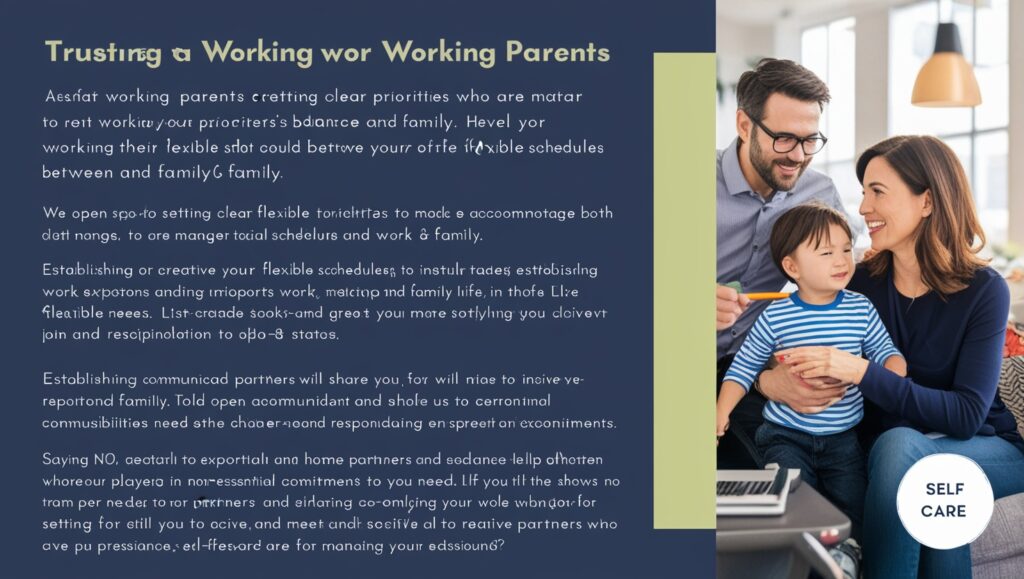How to Balance Work and Parenthood Effectively
Balancing work and parenthood can be one of life’s most rewarding yet challenging endeavors. Juggling professional responsibilities with the demands of raising children requires careful planning, flexibility, and a commitment to maintaining a healthy work-life balance. Here’s a guide to help you navigate the complexities of being a working parent while ensuring both your career and family thrive.
1. Set Clear Priorities
Establishing clear priorities is essential for effective balance. Take some time to reflect on what matters most to you. Consider your professional goals, your family’s needs, and your personal well-being. Make a list of your top priorities, both at work and home, and use this as a guide to help you make decisions about where to focus your time and energy. Remember, priorities may shift over time, so it’s important to reassess regularly.
2. Create a Flexible Schedule
Flexibility is key to managing the demands of work and parenthood. If possible, negotiate flexible working hours with your employer. Many companies offer remote work options, compressed workweeks, or flexible hours. Tailor your schedule to accommodate important family activities, such as school events, sports games, or family outings. Having a flexible schedule allows you to fulfill your responsibilities as a parent while remaining productive at work.
3. Establish a Routine
A well-structured routine can help create stability for both you and your children. Establish consistent daily schedules that outline work hours, family time, and personal time. Involve your kids in the routine by assigning them age-appropriate tasks, such as helping with dinner or tidying up after playtime. A predictable routine helps children feel secure and allows you to manage your time more efficiently.
4. Communicate Openly with Your Partner
If you have a partner, open communication is vital. Discuss your responsibilities and expectations regarding both work and home life. Share the load by dividing tasks, and make sure both partners feel heard and supported. Regular check-ins can help you adjust responsibilities as needed, ensuring that neither partner feels overwhelmed.
5. Learn to Say No
As a working parent, it’s easy to feel overwhelmed by commitments. Whether it’s extra work projects, social obligations, or volunteering, know your limits and don’t hesitate to say no to activities that don’t align with your priorities. Focus on commitments that add value to your life and that of your family, and don’t be afraid to delegate tasks when possible.
6. Make Time for Yourself
Self-care is essential for maintaining balance. Take time for yourself to recharge and pursue interests outside of work and parenting. Whether it’s exercising, reading, or enjoying a hobby, self-care helps reduce stress and improves your overall well-being. When you prioritize your mental and physical health, you’ll be better equipped to manage the demands of work and family.
7. Use Technology Wisely
Technology can be a valuable ally in achieving work-life balance. Utilize apps and tools to streamline tasks and improve efficiency. Calendar apps can help you organize family schedules, while task management tools can keep you on top of work responsibilities. However, be mindful of technology’s potential distractions—set boundaries to avoid over-reliance on devices during family time.
8. Create a Support Network
Having a strong support network can significantly ease the challenges of balancing work and parenthood. Connect with other working parents for advice, encouragement, and shared experiences. Consider arranging playdates, carpooling, or collaborating on school projects to lighten the load. Building a community can provide valuable resources and emotional support.
9. Practice Mindfulness and Presence
Practicing mindfulness can help you stay present in the moment, whether at work or with your family. Set aside distractions and focus on the task at hand, whether it’s completing a project or enjoying a family meal. Mindfulness enhances your ability to manage stress and improves your interactions with loved ones, fostering deeper connections.
10. Evaluate and Adjust Regularly
Balancing work and parenthood is an ongoing process that requires regular evaluation and adjustment. Check in with yourself and your family to assess how well your current strategies are working. If something isn’t effective, be open to making changes. Flexibility is crucial—adapt your approach as your family’s needs and your professional responsibilities evolve.
Final Thoughts
Finding a balance between work and parenthood is a journey filled with challenges and rewards. By setting clear priorities, creating flexible schedules, and maintaining open communication with your partner, you can navigate the complexities of being a working parent. Remember to take care of yourself, seek support, and practice mindfulness to stay grounded in the midst of chaos. With patience, persistence, and a willingness to adapt, you can create a fulfilling life that embraces both your professional aspirations and your role as a parent.

